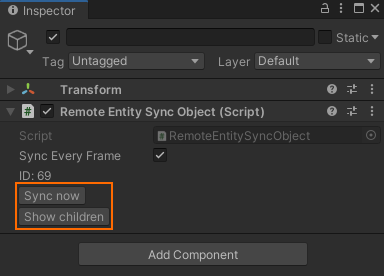Interact with Unity game objects and components
Azure Remote Rendering (ARR) is optimized for vast numbers of objects (see Limitations). While it's possible to manage large and complex hierarchies on the host, replicating them all in Unity on low-powered devices is unfeasible.
Therefore, when a model is loaded on the host, Azure Remote Rendering mirrors the information about the model structure on the client device (which will incur network traffic), but does not replicate the objects and components in Unity. Instead, it expects you to request the needed Unity game objects and components manually, such that you can limit the overhead to what is actually needed. This way you have more control over the client-side performance.
Consequently, the Unity integration of Azure Remote Rendering comes with additional functionality to replicate the Remote Rendering structure on demand.
Load a model in Unity
When you load a model, you get a reference to the root object of the loaded model. This reference is not a Unity game object, but you can turn it into one using the extension method Entity.GetOrCreateGameObject(). That function expects an argument of type UnityCreationMode. If you pass CreateUnityComponents, the newly created Unity game object will additionally be populated with proxy components for all Remote Rendering components that exist on the host. It is recommended, though, to prefer DoNotCreateUnityComponents, to keep the overhead minimal.
Load model with Unity coroutines
IEnumerator LoadModelWithCoroutine(RenderingSession session)
{
float currentProgress = 0.0f;
var task = session.Connection.LoadModelFromSasAsync(new LoadModelFromSasOptions("builtin://Engine"),
(float progress) =>
{
currentProgress = progress;
});
while (!task.IsCompleted && !task.IsFaulted)
{
int percentage = (int)(currentProgress * 100.0f);
yield return null;
}
if (!task.IsFaulted)
{
var gameObject = task.Result.Root?.GetOrCreateGameObject(UnityCreationMode.DoNotCreateUnityComponents);
}
}
Load model with await pattern
async void LoadModelWithAwait(RenderingSession session)
{
var result = await session.Connection.LoadModelFromSasAsync(new LoadModelFromSasOptions("builtin://Engine"), null);
var gameObject = result.Root?.GetOrCreateGameObject(UnityCreationMode.DoNotCreateUnityComponents);
}
The code samples above used the model loading path via SAS because the built-in model is loaded. Addressing the model via blob containers (using LoadModelAsync and LoadModelOptions) works fully analogously.
RemoteEntitySyncObject
Creating a Unity game object implicitly adds a RemoteEntitySyncObject component to the game object. This component is used to synchronize the entity transform to the server. By default RemoteEntitySyncObject requires the user to explicitly call SyncToRemote() to synchronize the local Unity state to the server. Enabling SyncEveryFrame will synchronize the object automatically.
Objects with a RemoteEntitySyncObject can have their remote children instantiated and shown in the Unity editor through the Show children button.

Wrapper components
Components attached to Remote Rendering entities are exposed to Unity through proxy MonoBehaviors. These proxies represent the remote component in Unity, and forward all modifications to the host.
To create proxy Remote Rendering components, use the extension method GetOrCreateArrComponent:
var cutplane = gameObject.GetOrCreateArrComponent<ARRCutPlaneComponent>(RemoteManagerUnity.CurrentSession);
Coupled lifetimes
The lifetime of a remote entity and a Unity game object is coupled while they are bound through a RemoteEntitySyncObject. If you call UnityEngine.Object.Destroy(...) with such a game object, the remote entity will be removed as well.
To destroy the Unity game object, without affecting the remote entity, you first need to call Unbind() on the RemoteEntitySyncObject.
The same is true for all proxy components. To destroy only the client-side representation, you need to call Unbind() on the proxy component first:
var cutplane = gameObject.GetComponent<ARRCutPlaneComponent>();
if (cutplane != null)
{
cutplane.Unbind();
UnityEngine.Object.Destroy(cutplane);
}